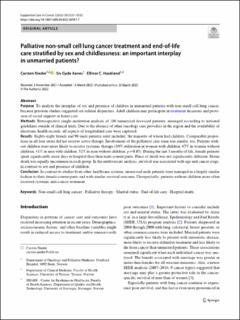| dc.contributor.author | Nieder, Carsten | |
| dc.contributor.author | Aanes, Siv Gyda | |
| dc.contributor.author | Haukland, Ellinor Christin | |
| dc.date.accessioned | 2023-01-20T10:23:55Z | |
| dc.date.available | 2023-01-20T10:23:55Z | |
| dc.date.created | 2022-04-10T14:31:48Z | |
| dc.date.issued | 2022 | |
| dc.identifier.citation | Nieder, C., Aanes, S. G., & Haukland, E. C. (2022). Palliative non-small cell lung cancer treatment and end-of-life care stratified by sex and childlessness: an important interplay in unmarried patients?. Supportive Care in Cancer, 30(6), 5527-5532. | en_US |
| dc.identifier.issn | 0941-4355 | |
| dc.identifier.uri | https://hdl.handle.net/11250/3044909 | |
| dc.description.abstract | Purpose
To analyze the interplay of sex and presence of children in unmarried patients with non-small cell lung cancer, because previous studies suggested sex-related disparities. Adult children may participate in treatment decisions and provision of social support or home care.
Methods
Retrospective single-institution analysis of 186 unmarried deceased patients, managed according to national guidelines outside of clinical trials. Due to the absence of other oncology care providers in the region and the availability of electronic health records, all aspects of longitudinal care were captured.
Results
Eighty-eight female and 98 male patients were included, the majority of whom had children. Comparable proportions in all four strata did not receive active therapy. Involvement of the palliative care team was similar, too. Patients without children were more likely to receive systemic therapy (39% utilization in women with children, 67% in women without children, 41% in men with children, 52% in men without children; p = 0.05). During the last 3 months of life, female patients spent significantly more days in hospital than their male counterparts. Place of death was not significantly different. Home death was equally uncommon in each group. In the multivariate analysis, survival was associated with age and cancer stage, in contrast to sex and presence of children.
Conclusion
In contrast to studies from other healthcare systems, unmarried male patients were managed in a largely similar fashion to their female counterparts and with similar survival outcome. Unexpectedly, patients without children more often received systemic anti-cancer treatment. | en_US |
| dc.language.iso | eng | en_US |
| dc.publisher | Springer Link | en_US |
| dc.rights | Navngivelse 4.0 Internasjonal | * |
| dc.rights.uri | http://creativecommons.org/licenses/by/4.0/deed.no | * |
| dc.title | Palliative non-small cell lung cancer treatment and end-of-life care stratified by sex and childlessness: an important interplay in unmarried patients? | en_US |
| dc.title.alternative | Palliative non-small cell lung cancer treatment and end-of-life care stratified by sex and childlessness: an important interplay in unmarried patients? | en_US |
| dc.type | Peer reviewed | en_US |
| dc.type | Journal article | en_US |
| dc.description.version | publishedVersion | en_US |
| dc.rights.holder | The author | en_US |
| dc.subject.nsi | VDP::Medisinske Fag: 700 | en_US |
| dc.source.pagenumber | 5527-5532 | en_US |
| dc.source.journal | Supportive Care in Cancer | en_US |
| dc.identifier.doi | 10.1007/s00520-022-06987-7 | |
| dc.identifier.cristin | 2016485 | |
| cristin.ispublished | true | |
| cristin.fulltext | original | |
| cristin.qualitycode | 1 | |

